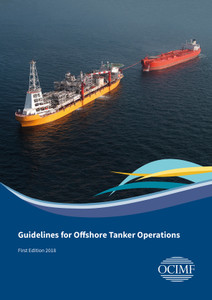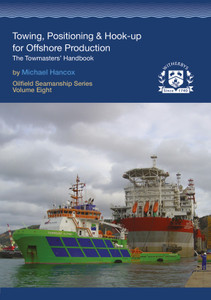
This guide provides technical recommendations and guidance to help ensure the satisfactory performance?of hoses commonly used at offshore moorings.
Now in its 5th edition, this guide to hoses (elastomer reinforced, smooth bore, oil suction and discharge hoses) commonly used at offshore moorings has been fully updated to incorporate technical recommendations and guidance designed to help ensure satisfactory performance.
New or significantly revised topics covered in this latest edition include:
- The guidance for reeling hose systems is addressed for the first time with particular attention being given to the potential for hoses being subjected to crush loading
- a commentary comparing the design and operating guidance of ‘oil’ hoses and hoses specifically designed for LPG is included to assist operators when considering hose used in the offshore transfer of LPG
- the Safe Working Loads guidance for hose lifting lugs has been reassessed based on the weights of double carcass hoses equipped with typical fittings
- the design specification for double carcass hoses has been clarified, together with the guidance for leak detection
- acceptance tests include new guidance for material tests, and the process for stiffness testing has been revised
- the circumstances that prompt prototype tests have been clarified and new tests addressing materials, torsion, tensile loading, crushing and lifting lugs have been introduced into the prototype test programme. This programme now also includes guidance for the dynamic testing of prototype hoses.
GMPHOM 2009 consolidates the Guide to Purchasing, Manufacturing and Testing of Loading and Discharge Hoses for Offshore Moorings, 4th Edition (1991) and SPM Hose System Design Commentary (1993).
This Guide, which supersedes the 4th edition of the ’Guide to Purchasing, Manufacturing and Testing of Loading and Discharge Hoses for Offshore Moorings’, published in 1991, has been prepared by OCIMF with the purpose of providing technical recommendations and guidance to ensure the satisfactory performance of elastomer reinforced, smooth bore, oil suction and discharge hose commonly used at offshore moorings. The recommendations and guidance within this Guide shall not be construed as establishing standards or requirements for application to offshore equipment.
The 4th edition published in 1991 will be withdrawn in June 2012. Although manufacturers may choose to continue to be guided by 4th edition until it is withdrawn, this 5th edition reflects a major review and enhancement of the 4th edition. The 1993 OCIMF publication ‘SPM Hose System Design Commentary’ is now superseded by this Guide and relevant issues are now included in Part 5.
The following are among the new or significantly changed topics that are included in this latest edition:
- The guidance for reeling hose systems is addressed for the first time, with particular attention being given to the potential for hoses being subjected to crush loading
- a commentary comparing the design and operating guidance of ‘oil’ hose and hose specifically designed for LPG is included to assist operators when considering hose used in the offshore transfer of LPG
- the Safe Working Loads guidance for hose lifting lugs have been re-assessed based on the weights of double carcass hoses equipped with typical fittings
- the design specification for double carcass hoses has been clarified, together with the guidance for leak detection
- acceptance tests include new guidance for material tests and the process for stiffness testing has been revised
- the circumstances that prompt prototype tests have been clarified and new tests addressing materials, torsion, tensile loading, crushing and lifting lugs have been introduced into the prototype test programme. This programme now also includes guidance for the dynamic testing of prototype hoses.
Metric units are used for all dimensions including nominal diameter and standard length.
Hoses constructed and tested in accordance with recommendations and guidance in this Guide may be stamped ‘GMPHOM 2009’.
OCIMF are not involved with any verification or quality control process relating to the manufacture and/or testing of hoses. OCIMF does not control or regulate in any way the stamping of ‘GMPHOM 2009’ on hoses. Prospective purchasers are therefore recommended to undertake a due diligence process to ensure that the hose specification is as claimed by the manufacturer/seller and that the specification is suitable for their intended application.
Nothing in this Guide shall be construed to prevent the use of newly developed designs, materials or techniques which have been demonstrated by the manufacturer and the use of which has been agreed to by the purchaser.
Section 1: Technical Requirements for Commercial Hose
1.1 Scope
1.2 Performance Requirements?
1.3 Length?
1.4 Flexibility?
1.5 Construction
1.6 Submarine Hose?
1.7 Floating Hose?
1.8 Tanker Rail Hose
1.9 Double Carcass Hose
1.10 Reinforced Hose
1.11 Reeling Hose Systems
1.12 Hoses for Offshore Marine LPG Applications
?
Section 2: Acceptance Tests, Inspection Procedures and Delivery
2.1 Acceptance Tests?
2.2 Inspection
2.3 Inspection and Test Certificates?
2.4 Manufacturer’s Report?
2.5 Marking?
2.6 Quality Assurance
2.7 Packing
?
Section 3: Technical Requirements for Prototype Hose Approval
3.1 Scope?
3.2 Prototype Hose?
3.3 Prototype Document Package?
3.4 Required Tests for Prototype Hose
??
Section 4: Purchaser’s Inspection Guide
4.1 Scope
4.2 General?
4.3 Documentation
4.4 Inspection Procedures?
4.5 Acceptance Tests?
4.6 Test Certificates
4.7 Pre – Shipment Inspection and Packing
?
Section 5: Considerations Relating to Hose System Design
5.1 Hose System Designs
5.2 Floating Hose String Lengths
5.3 Use of Electrically Discontinuous Hoses
5.4 Marine Breakaway Couplings?
5.5 Recommended Actions after a Surge Event
5.6 Hose Lifting Weights
The Oil Companies International Marine Forum (OCIMF) is a voluntary association of oil companies with an interest in the shipment and terminalling of crude oil, oil products, petrochemicals and gas. OCIMF focuses exclusively on preventing harm to people and the environment by promoting best practice in the design, construction and operation of tankers, barges and offshore vessels and their interfaces with terminals. Learn more at www.ocimf.org
- Number of Pages:
- 90
- ISBN:
- 9781905331888
- Published Date:
- November 2009
- Binding Format:
- Hardback
- Book Height:
- 300 mm
- Book Width:
- 210 mm
- Weight:
- 0.8 kg
- Preview:
- Yes
- Author:
Oil Companies International Marine Forum
 Witherbys.com
Witherbys.com





